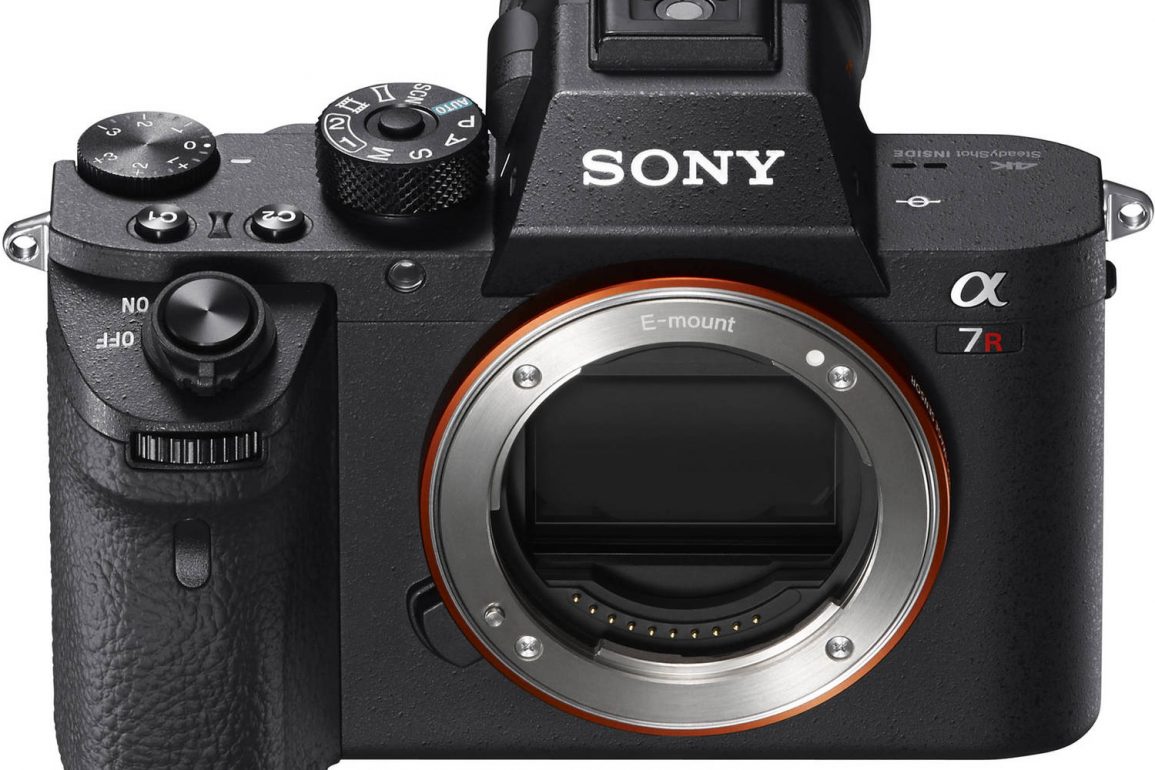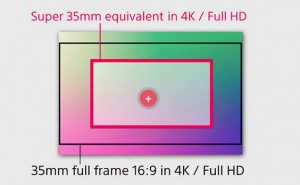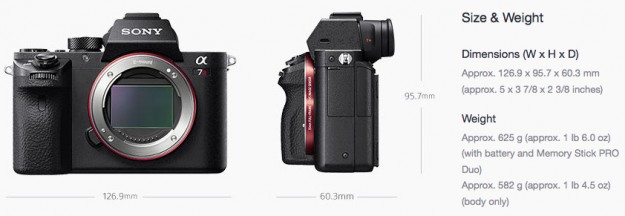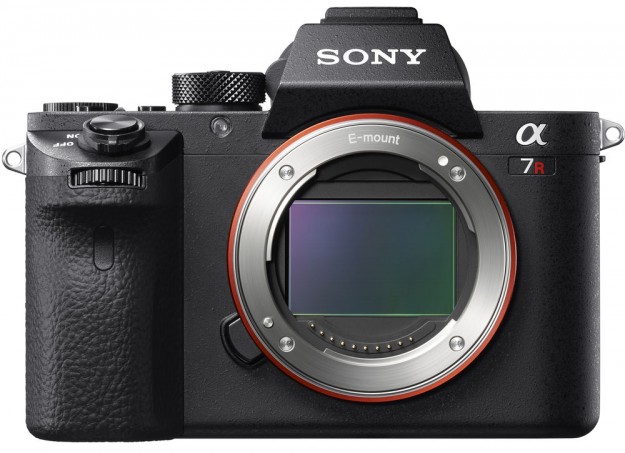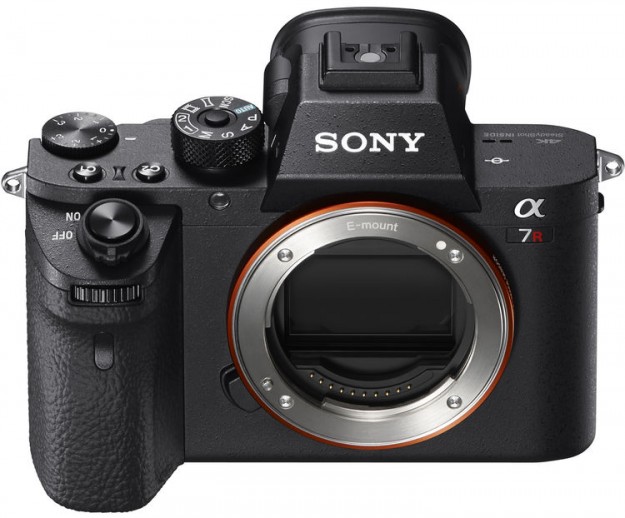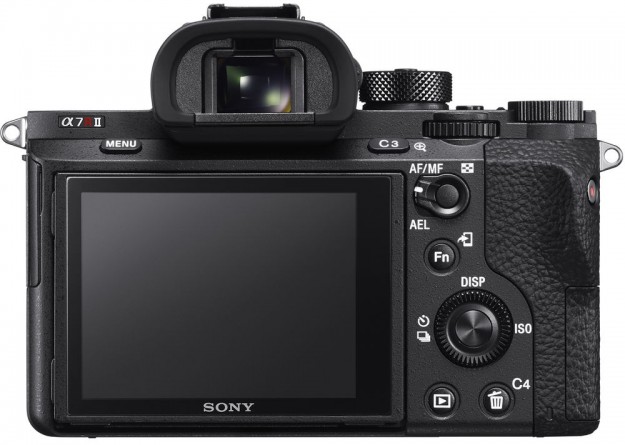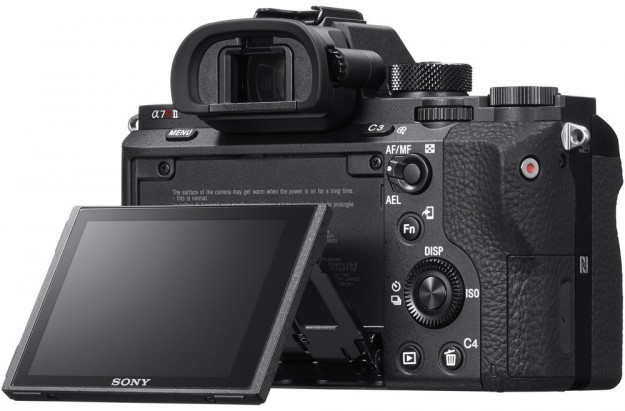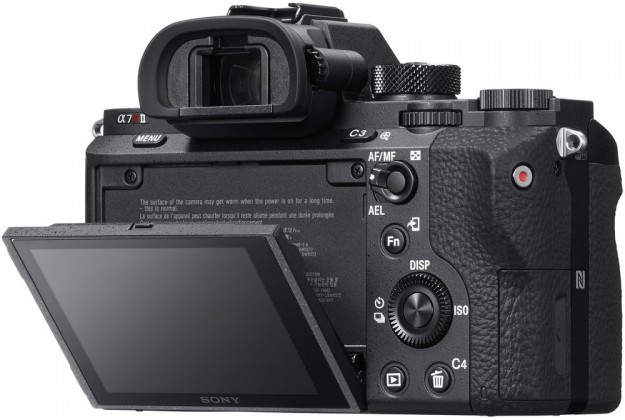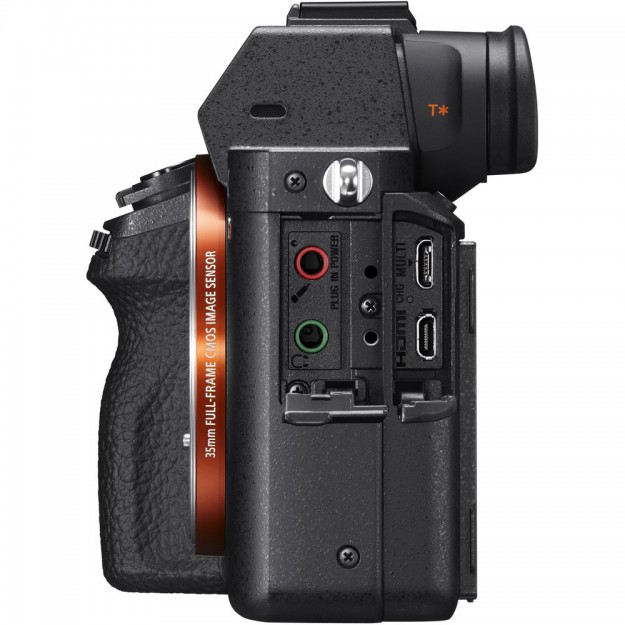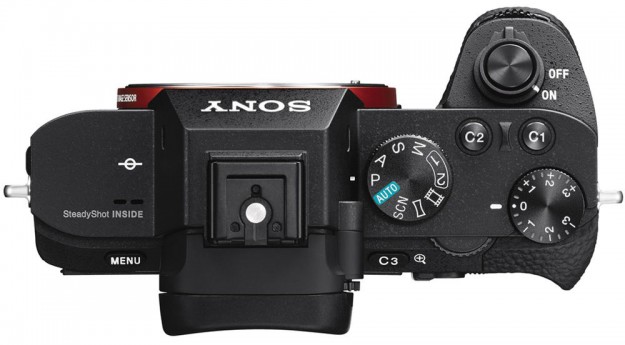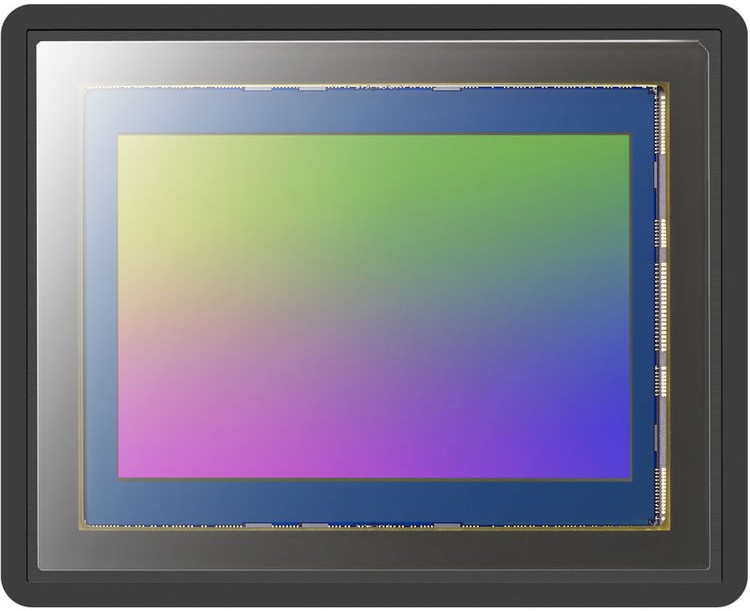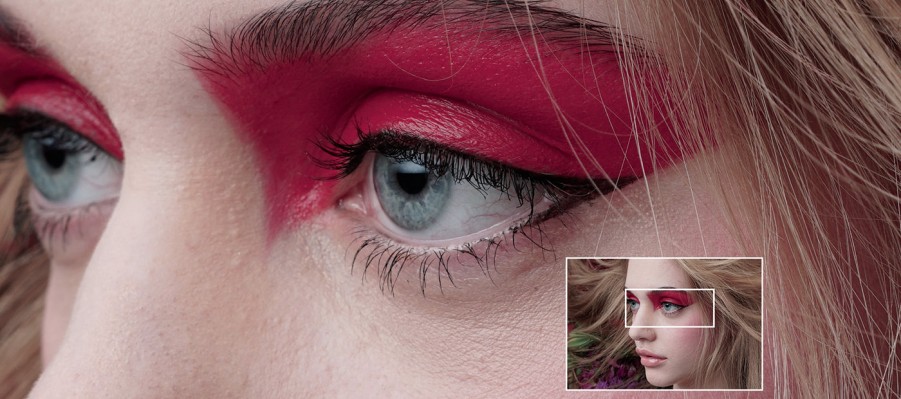So lets break this new Sony Alpha A7r II down properly now that we have all digested the initial announcement hype and so fourth…. The $3198 US price tag is starting to become an issue on the web, but we must remember that the original A7r cost $2298 US when it first came out. Then adding all the new features to that price point and we end up in the $3000 area really fast.
Sony decided to upgrade a lot of hardware on this unit and not just cheap gimmick software updates either. We’re talking new sensor, new body, and very powerful features like 5-axis steadyshot, Second generation Hybrid AF, Silent Shooting w/ new shutter, and 4k video recording at 100Mb/s to the memory card, and a new .78x Viewfinder! Those new features basically added $1000 dollars to the camera and I honestly think that is about right considering the power and cost of the actual hardware added.
Therefore, with the number of new extremely powerful features offered on the A7r II, the price does appear reasonable in my opinion. The A7 II costs ($1698 US), but only has the new camera body with IBIS, and nothing else very special. The current low light champ A7s camera ($2498 US), is $900 more than the newer A7 II and only offers a killer sensor and some killer video features in the old generation one body.
Sony does price for the market and clearly no competition really exists for a beast like the new A7r II full frame mirrorless camera when you factor in all the new features and technology. It’s now competing directly with a lot of DSLR’s in my opinion at this point. The focus should now be up to a good enough standard to use in low light studio environments and have accurate focus in a timely manner. This was not possible with the A7r unless the modeling lights were fairly bright. The focus time would cost some shots in the studio and made the DSLR a preferred unit for this type of photography. Now, perhaps the studio environment and low light wedding work will be usable for pros? I would love to have had the IBIS and super fast primes for weddings back in the day. I used the EF 135mm f/2 L lens on my Canon 5d Mark II and nothing was stabilized. This is what lot of pros use in these situations, so the 5-axis steadyshot is a huge deal if the focus can keep up of course.
The M43 sensor Olympus EM5 Mark II which I just reviewed here, offers a lot of features like the New A7r II, but the sensor is so much smaller the hardware required is not as robust or expensive to produce. Hence the price point differences even though the features are similar. The full frame sensor requires much more money to dress up with features due to the huge size in my opinion. The silent shutter feature and new shutter mechanism, for example, is not exactly cheap compared to the clunky beast that was in the original A7r I would gather.
These new powerful features cost money is the bottom line, and that is what I’m trying to get across here as best I can. I would love to see a much cheaper price for the A7r II camera, but I also don’t want to see Sony taking a loss on cameras to gain market share… I wonder what the actual cost per unit is to manufacture for real? ~$2k maybe? Honestly don’t know, but that sounds about right to me just totally guessing 😉
Now, lets take a look at the new A7r II in more detail:
Camera Body – High Res Detail Photos
From the front you can see the new A7 II body has been used for the A7r II body as well. There is no Mark II logo on the front like on the new RX10 II or A7 II for example, because it’s now on the back 😉 You can also see how much taller the new locking mode dial is from this angle. Other than that it looks near identical to the A7 II body from the front. Jut below the mode dial you can see the AF assist light which should clear the fingers and most lenses with no issue.
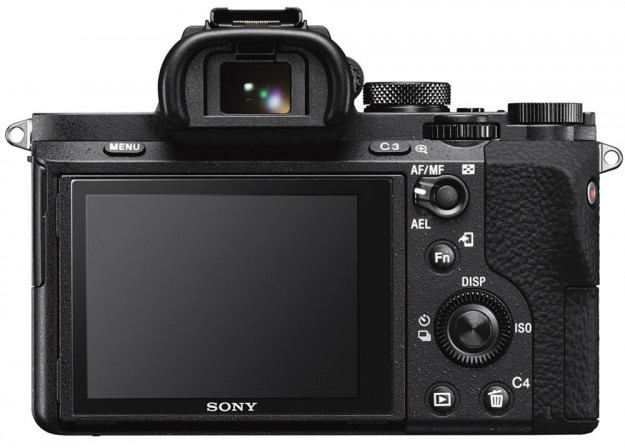
From this angle you can see the Mode dial has a lock button which is new to A7r II model over the A7 II. Reports are the knobs might be a bit smoother in dampening as well. Note the 4k logo on the right top picture below as well. The flash hot shoes housing is slightly different from the A7 II as well.
From the back you can see the A7RII logo on the top left which is a pretty good spot I would say. The eyepiece cup is designed a bit different as you can see below. Everything else appears the same as the A7 II as far as I can tell.
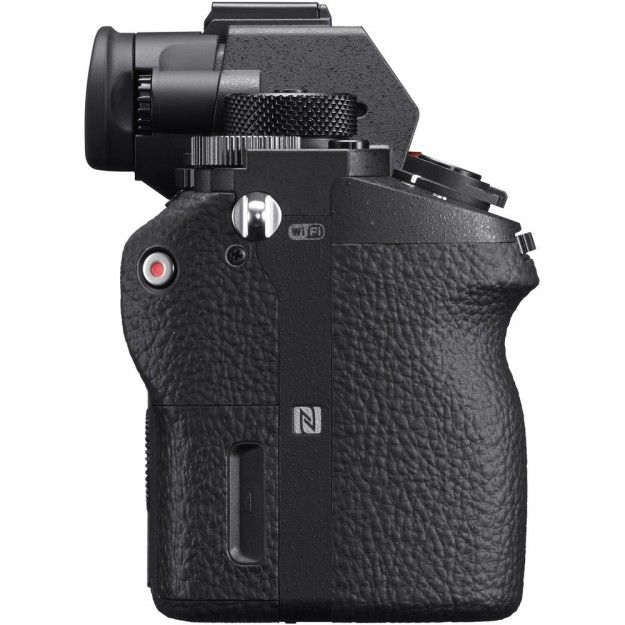
The port area doors looks the same as the A7 II as far as I can tell, but the rubber may be different compound possible. Hopefully more rubbery…
From the top you can clearly see the lock button in the center of the mode dial and notice the changes in the Eye-piece plus hot-shoe area. The 4k Logo is very noticeable as well from above.
Here is the A7 II top for comparison.
And the down under.
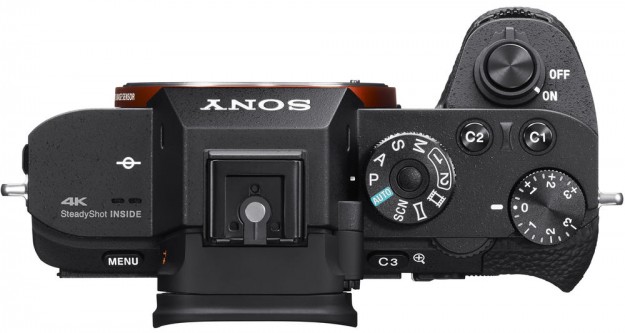
Note how the A7 II eye piece differs below and the lack of logo on the top left. Also, check out how much taller the locking mode dial is above on the A7R II.
The grip also looks the same as the A7 II and hopefully Sony increased the click resistance on the memory card door, so it does not open so easily. That bothered me a little bit about the A7 II door if you remember from the full review.
A7r II – Specs That Matter:
- New Gen 2 Camera Body w/ 5-Axis Steadshot
- Full Magnesium Alloy Chassis and Dust/ Moisture Resistant body
- New Mode Dial Lock
- New 42.4mp Sensor w/ 399 Hybrid AF pts (7952 x 5304)
- New anti-reflective sensor coating
- No optical Low-pass filter
- 14-bit Raw Output
- Max ISO 102,400 (2-stops improvement)
- New Silent shutter, first curtain shutter
- New 1,228.8k-dot LCD Screen (RGBW pixel structure)
- New 4k internal video recording, X AVCS @ 100mb/s
- S-Log2 Gamma and S-Gamut settings, 120fps
- Timecode and User bit settings for video
- Reported much better autofocus with third party lenses
- 5fps continuous shooting with AF tracking
- New 0.5″ 2.36M-Dot XGA OLED Tru-Finder EVF (0.78x)
- Built-In Wi-Fi Connectivity with NFC
- $3198 US
World’s first1 back-illuminated full-frame sensor
Higher resolution, sensitivity, and readout speed
As the world’s first1 35 mm full-frame image sensor with back-illuminated structure, this 42.4-megapixel CMOS sensor enhances light collection efficiency, expands circuitry scale, and, with the help of a quick-transmission copper wiring layer, outputs data about 3.5 times faster4, while minimizing image noise to reveal fine details in every picture.
New 42.4 MP Exmor R BSI CMOS Sensor:
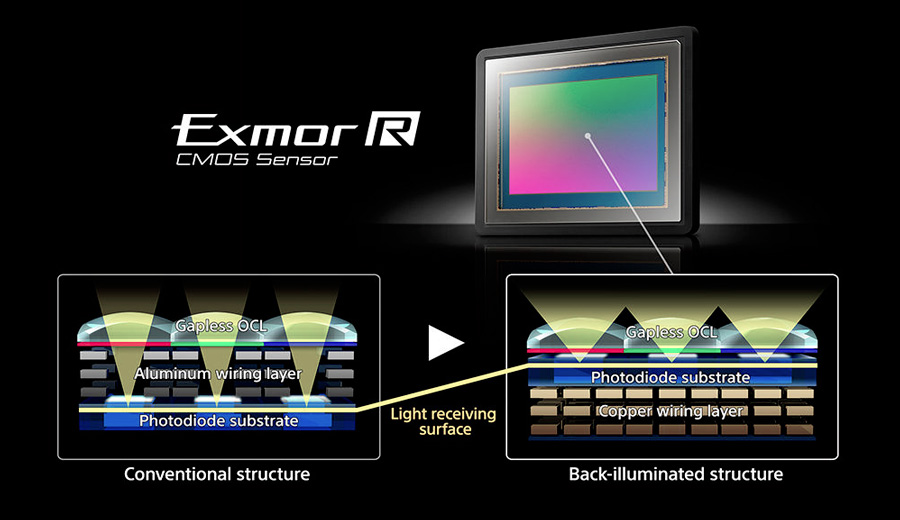
The world’s first back-illuminated full-frame sensor, the 42.4-megapixel Exmor R CMOS sensor present in the a7RII works with the BIONZ X image processor to offer high-resolution stills and video while minimizing noise and improving speed. This sensor structure works with gapless on-chip lens design and an anti-reflection coating, as well as eliminating the optical low-pass filter, to improve light collection and enhance detail. The copper wiring layer dramatically improves data transmission speed for creating high-resolution 42.4-megapixel stills at sensitivities up to ISO 102,400. Also, it enables internal UHD 4K video recording with a wide dynamic range using the full-frame sensor.
Sensor Layer Technology Illustration:
No Optical Low-Pass Filter:
Fast Hybrid AF with 399 Phase-Detect Points
Lock onto your subjects quickly and without hesitation thanks to the revamped Fast Hybrid AF packed into the a7RII. It uses 399 on-sensor phase-detect AF points with 45% coverage along with 25 contrast-detect AF points in order to improve the speed, accuracy and tracking performance of the system. Faster readout thanks to the back-illuminated sensor structure also allows for tracking while shooting at the top continuous shooting rate of 5 fps. This can be captured in a burst of up to 24 frames when shooting in JPEG Fine L format at 42 MP and a continuous AF Display allows users to view the active AF points.
Another feature available with this AF system is a Lock-on AF tracking that will analyze more information from the scene to provide dramatically improved accuracy and stability. Eye AF is also available which will prioritize a subject’s pupil for excellent portraits even with a shallow depth of field.
Silent Shutter Feature
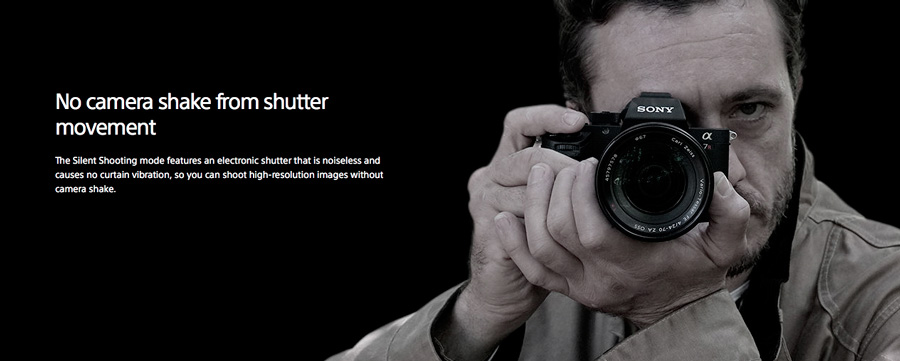

XGA OLED Tru-Finder makes every view a vision
4K movie quality hits an all-time high
The ultimate high-resolution movie experience
You can see how the A7R II is optimized for recording 4K (QFHD: 3,840 x 2,160) movies, particularly in Super 35 mm format, as it processes readout data from every pixel without pixel binning, to effectively suppress jaggies and moiré. The resulting footage exhibits visibly sharper, finer, more subtle detail than typical 4K movies. Also, as the first1 full-frame camera that can record movies at 4K resolution in the 35 mm full-frame format, the a7R II extends your power to express qualities of vision that the newly developed, back-illuminated full-frame image sensor makes possible.
Clean HDMI output
This function supports 4K and Full HD and allows uncompressed movie output to an external recorder or monitor. The image can also be recorded in the camera even while signals are output using this function. The included cable protector guards jacks and prevents cables from disengaging accidentally, so you can shoot with greater assurance.
Closing Remarks:
I really hope you guys got all the info you were looking for in this Sony Alpha A7r II Breakdown article 😉 Obviously I will review this camera as soon as possible and really look forward to it as well! If I missed anything or left something out, please let me know! I think I covered everything that matters though 😉
Questions or Comments?? Please reply below and will be sure to answer as best I can asap.
Thanks,
Jay

